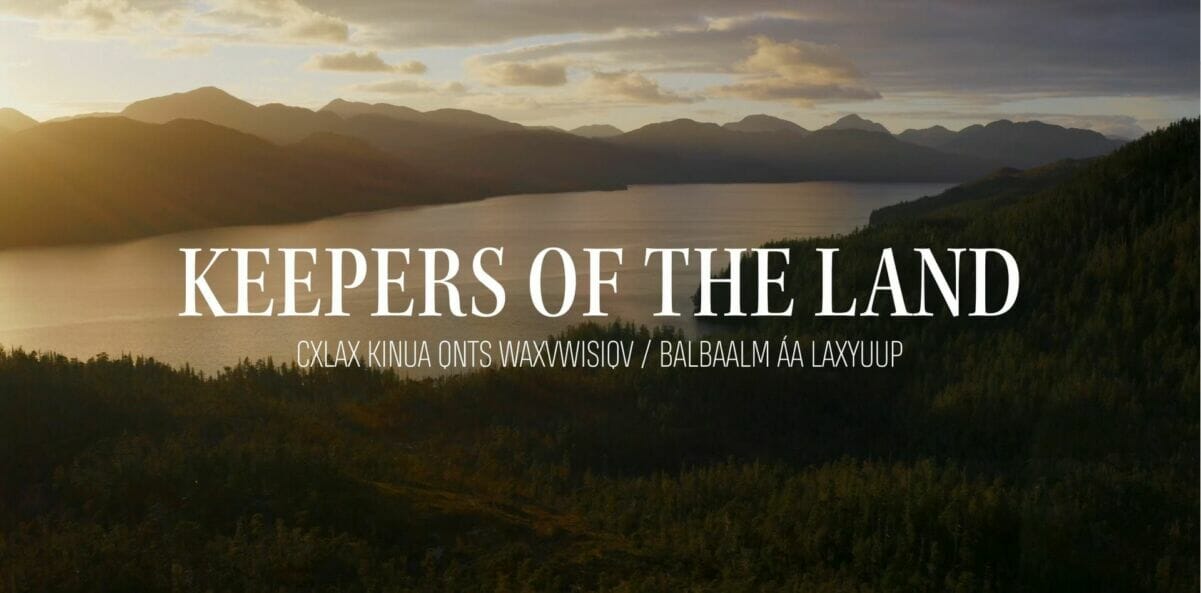Estimated Reading time

12 Mins
2023 in Review: 23 Good News Stories from First Nations
Over the last year, First Nations have won widespread recognition for their efforts to steward their territories, revitalize their languages and cultures, and build sustainable, local economies.

Up and down the coast, First Nations are making headlines, winning recognition for their Guardian and stewardship departments, for their investments in businesses and sustainable energy projects, and for their efforts to revitalize language and culture.
In 2023, Nations in the Great Bear Rainforest and Haida Gwaii declared new protected areas, increased the reach of their stewardship programs, and made significant progress on securing protections and conservation financing for stewardship of the Great Bear Sea.
On the world stage, Indigenous leaders shared their knowledge and visions for the future at international gatherings like IMPAC5, COP28, and GEF. At home, Nations continued creating local jobs and businesses and made strides towards energy sovereignty. In the face of climate change, they fought wildfires, restored critical habitats for keystone species, and doubled down on ecotourism initiatives that put people and place first. And that’s only scratching the surface.
In the sections below, our team has rounded up 23 wins from First Nations across five themes:
- Stewardship and Conservation
- Sustainable Energy
- Science and Research
- Ecotourism and Sustainable Economies
- Language and Cultural Revitalization
Stewardship and Conservation
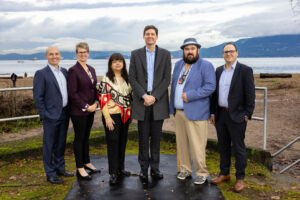
1. First Nations partnered with Crown governments to announce major investments in Indigenous-led conservation.
In October, Indigenous leaders joined the Province of BC and the BC Parks Foundation to announce the creation of a $300-million conservation financing mechanism, which will support Indigenous-led conservation projects and old-growth forest protections.
Building on that announcement, the First Nations Leadership Council, the Government of Canada, and the Province of BC announced a $1-billion tripartite agreement on nature conservation. The agreement aligns funding streams, affirms Indigenous leadership in conservation decision-making, and sets out a path towards protecting 30% per cent of land in BC by 2030.
And in December, the BC announced an additional $60-million investment in support of Indigenous-led marine stewardship and sustainable economic development in the Northern Shelf Bioregion, also known as the Great Bear Sea.
“By protecting whole ecosystems that include people and communities in co-existence with natural ecosystems, Indigenous-led stewardship provides a blueprint for conservation and sustainable resource management worldwide.”
— K̓áwáziɫ Marilyn Slett, Chief Councillor of the Heiltsuk Tribal Council and President of Coastal First Nations-Great Bear Initiative
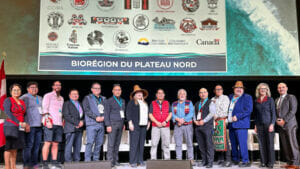
2. First Nations have shared their action plan for a network of marine protected areas in the Great Bear Sea.
At the IMPAC5 conference in February, First Nations leaders stood shoulder-to-shoulder with provincial and federal government officials to announce and endorse their action plan for a network of marine protected areas (MPAs) in the Northern Shelf Bioregion (aka, the “Great Bear Sea”).
To finance their marine stewardship and Guardian programs, along with community development and new businesses, First Nations are working with Coast Funds to develop a new project finance for permanence (PFP) initiative for the Great Bear Sea, which will deliver durable, long-term funding.
3. More Indigenous Protected and Conservation Areas (IPCAs) were declared.
This year, First Nations added to the growing roster of IPCAs, starting in January with the Taku River Tlingit First Nation who declared an IPCA for the 1.8-million-hectare Taku watershed, the largest intact watershed on the Pacific Coast of North America and a rich ecological refuge.
In March, the Simpcw First Nation followed suit with their own IPCA declaration for the Raush River watershed on the south coast, which contains a rare inland rainforest and surrounds two existing provincial protected areas.
Towards the end of the year, the Kwiḵwa̱sut’inux̱w Ha̱xwa’mis First Nation declared a new, 40,000-hectare IPCA that covers parts of Hada Bond Sound and Kakweikan Thompson Sound from “mountaintop to seafloor.” This declaration signals a move by the Nation to lead on stewardship of the region and to restore and protect wildlife habitat, archaeological sites, and harvesting sites.
“The declaration is going to give us the ability to have a say in what we want there, what we want to put there.”
— Chief Rick Johnson of the Kwiḵwa̱sut’inux̱w Ha̱xwa’mis First Nation (via The Narwhal)
4. Indigenous-led conservation shines on the world stage (and big screen).
Indigenous-led conservation cast a bright light this year. Speakers at conferences like COP15 (the UN’s biodiversity conference), COP28 (the UN’s climate change conference), and IMPAC5 (the fifth annual International Marine Protected Areas Congress) affirmed that Indigenous-led conservation is the key to achieving Canada’s—and the world’s—biodiversity goals.
At COP15, the Indigenous Leadership Initiative announced the creation of a Canada-wide First Nations Guardian Network to streamline funding, training, and supports for Guardian programs.
At COP28, the First Nations Climate Initiative, which includes members from the Haisla, Nisg̲a’a, and Metlakatla Nations, joined Canada’s delegation to share nature-based solutions being implemented in their traditional territories.
On the big screen, Keepers of the Land, a Kitasoo Xai’xais-produced documentary on the Nation’s stewardship efforts, was nominated for the Global Voices Award at the prestigious Jackson Wild film festival. The documentary highlights the ways in which Kitasoo Xai’xais hereditary and elected leaders, Guardians, and youth are coming together to pass on important knowledge, safeguard their cultural identity, and protect their territory from exploitation.
5. First Nations doubled their efforts to clean up shorelines.
Building on the success of last year’s coastal cleanups, First Nations have doubled their efforts through the Clean Coast, Clean Waters initiative to remove fishing gear, plastics, and foam from shorelines on the north and central coast and Haida Gwaii. To date, First Nations have helped clean up 4,600 kilometres of shoreline, creating more than 1,700 well-paying jobs.
Sustainable Energy
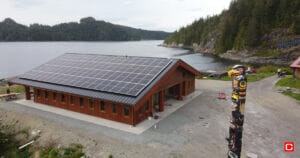
6. First Nations secured more funding for sustainable energy projects.
In 2023, First Nations secured another $30 million in funding for the Community Energy Diesel Reduction (CEDR) program, doubling its size from $29 to $59 million. A partnership between New Relationship Trust, Coast Funds, and the Province of BC, CEDR supports First Nations to invest in energy planning, demand side reduction and energy efficiency, and renewable energy projects, including feasibility studies, design, engineering, and construction.
7. Haida-owned Tll Yahda Energy was named “Community of the Year” by Clean Energy BC.
Tll Yahda Energy (TYE) – which includes Old Masset Village Council, Skidegate Band Council, and the Council of the Haida Nation – was recognized with the Community of the Year award at the Clean Energy BC. TYE is completing a two-megawatt solar farm on Haida Gwaii, which will reduce diesel usage by nearly nine per cent and reduce the Nation’s emissions by over 1,700 tonnes per year. The solar farm is the first of many efforts to eradicate diesel emissions from the islands by 2030.
“Out of all of the major renewable energy projects in the last 10 years, the majority have been Indigenous-led. We’re on the forefront of that renewable energy frontier that’s coming.”
— Nang Hl K’aayaas Sean Brennan, implementation manager for Tll Yahda Energy (via CFN-GBI)
8. Indigenous-owned K’uul Power will lead renewable energy projects in the northwest.
Eleven First Nations, including the Kitsumkalum, Kitselas, Nisg̱a’a, and Haisla, came together to form K’uul Power, an Indigenous-owned and -led organization that will pursue ownership and development of renewable energy projects in northwest BC.
9. The Kitselas First Nation is investing in geothermal energy.
Kitselas First Nation is looking to tap into the power of geothermal energy in their traditional territories. In October, the Nation secured funding through the PacifiCan’s Jobs and Growth Fund to drill production wells. The project is expected to create 170 jobs and replace 270,000 gigajoules of natural gas per year, reducing greenhouse gas emissions by over 13,000 metric tonnes per year.
Science and Research

10. First Nations contributed research to better protect humpback whales in high-traffic marine areas.
Guardians and stewardship staff from Gitga’at, Kitasoo Xai’xais, and Haíɫzaqv Nations contributed their research and knowledge to Whale Sound, a collaborative project that allows researchers and the public to learn about whale acoustics and how that data might better protect marine mammals moving forward.
Following a summer increase in humpback whale strikes in their waters, Gitga’at researchers and Guardians called for stronger measures to protect whales.
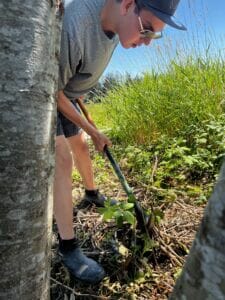
11. First Nations Guardians responded to oil spills, delivered stewardship training, and worked to restore critical estuaries and habitat.
In April, Wei Wai Kum, We Wai Kai, Tlowitsis, and K’ómoks Guardians were first on the scene when a tanker carrying 17,000 litres of diesel fuel rolled off a barge into a sensitive environmental area in the Nations’ territories.
Guardians from the Wei Wai Kum and We Wai Kai are continuing work to revitalize the Campbell River watershed, removing invasive plants from local watersheds, planting trees and shrubs, and taking other habitat protection measures. Further south, the K’ómoks Guardians are partnering with conservation groups to restore Kus-kus-sum and the Xwésam Salmon River estuary.
Through a partnership with Vancouver Island University, the Na̲nwak̲olas Council is expanding the Stewardship Technician Training Program (STTP), which supports Guardians to learn some of the skills needed to protect their territories.
“We need Guardian capacity to respond to crises like the sinking of barges and tugs carrying oil and other toxic pollutants… Having stable, well-funded training programs in place like the STTP to support that exponential increase in capacity will serve to benefit everyone on the coast.”
— Dallas Smith, President Na̲nwak̲olas Council
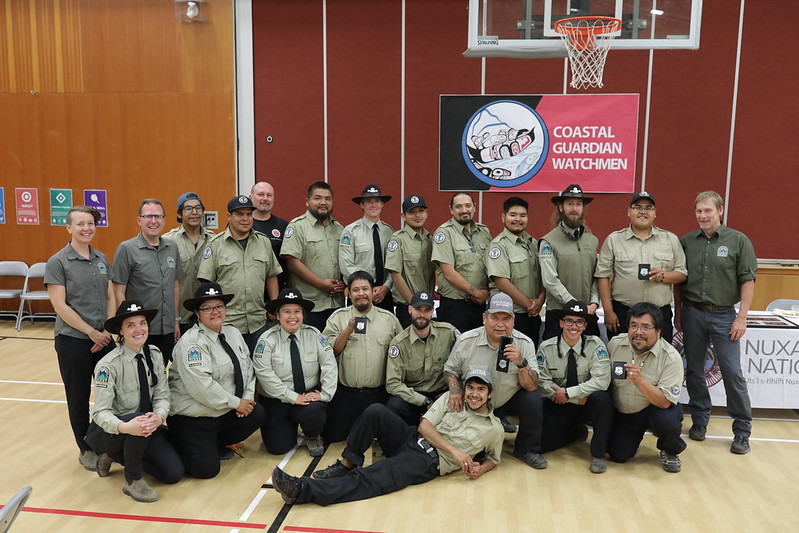
12. Nuxalk and Kitasoo Xai’xais Guardians now officially carry the same legal authority as B.C. Parks rangers.
After the successful launch of a pilot program in 2022, Guardians from the Nuxalk and Kitasoo Xai’xais Nations now carry the same legal authority as BC Parks Rangers within protected areas in their ancestral territories.
13. Haida Nation’s efforts to reduce invasive species receive growing recognition.
This fall, The Guardian ran feature stories on the historical and modern impacts of invasive species on Haida Gwaii, including European green crabs, deer, and rats, and the Haida Nation’s efforts to manage these complex ecosystems.
14. The Heiltsuk Integrated Resource Management Department is using AI to better identify and track salmon in their territory.
The Heiltsuk Integrated Resource Management Department is harnessing the power of artificial intelligence. This fall, the stewardship department of the Haíɫzaqv Nation used Salmon Vision, an AI tool that tracks and identifies salmon species in real-time, to count salmon in the Koeye River.
“It definitely increases a lot of our capacity for the Nation and field technician and if [we] have some of this work happening through AI, it allows our crews to focus more efforts on other areas that we normally wouldn’t have time to get to.”
— William Housty, associate director for the Heiltsuk Integrated Resource Management Department (via CBC)
Ecotourism and Sustainable Economies
15. A landmark agreement between four First Nations and Western Forest Products ushers in a “new model of forestry.”
In October, the Tlowitsis, We Wai Kai, Wei Wai Kum, and K’ómoks First Nations purchased a 34 per cent stake in a limited partnership with Western Forest Products, granting the Nations access to forestry tenure in their traditional territories and ensuring Indigenous participation in a more sustainable forestry industry.
“As First Nations, we all look forward to taking our rightful place in forestry ownership and management in our territories.”
— Ken Price, Chief Councillor, K’ómoks First Nation (via Na̲nwak̲olas)
16. Haida Tourism won a 2023 Global Vision Award.
In March, Haida Tourism was recognized by Travel + Leisure Magazine as the top hospitality brand leading the way in conscious, environment-minded travel. The Nation also released a new video on the Haida Gwaii Pledge, which asks visitors to follow Haida teachings such as yahguudang / yahgudáng respect for all beings when travelling to Haida Gwaii.
17. Gitxaała Enterprises Corporation greatly expanded its economic portfolio.
In May, the Gitxaała Enterprises Corporation purchased the Crest Waterfront Hotel, a long-standing, premier hotel property in Prince Rupert, and opened Salt Water Bakery & Provisions, an artisanal bakery in Cow Bay.
18. We Wai Kai First Nation broke ground on the first Indigenous-operated Starbucks in Canada.
In March, the We Wai Kai First Nation broke ground on the site of the first Indigenous-led Starbucks in Canada. The location is set to open in the coming year and will be staffed by We Wai Kai members.
“For us to have self-determination, we need to get into these partnerships and Starbucks to us was right at the top of the list. Economically this is a big boost to our Nation.”
— Ronnie Chickite, Chief Councillor, We Wai Kai Nation (via Black Press)
19. After a five-year closure, the Metlakatla First Nation welcomed guests back to the Metlakatla Wilderness Trail.
After revitalizing the 20-kilometre-long Metlakatla Wilderness Trail, the Nation reopened the trail to guests for the summer season. The trail, which features three suspension bridges and a viewing platform, offers significant recreation and cultural opportunities for the Nation’s members, as well as educational opportunities for school groups in the Prince Rupert area to learn about the traditional territories of the Metlakatla people.
Language and Cultural Revitalization

20. The Haida Nation’s Nang K̲’uula / Nang K̲’úulaas Recognition Agreement was passed into law.
In May, delegates from the Haida Nation travelled to the Legislative Assembly of BC to witness the passing of the historic Haida Declaration Act, which recognizes the Haida Nation’s inherent right to governance and self-determination and the Council of the Haida Nation as the rightful governing body of the Haida Nation.
“This act begins to right that wrong and serves to lay a proper foundation for negotiations of recognition of Haida title. Today, we are finally able to acknowledge each other and to work, government-to-government, with respect and integrity.”
— Gaagwiis Jason Alsop, President of the Haida Nation
21. First Nations community members used arts and digital tools to revive their languages and stories.
- Saltwater Hank, a Ts’msyen folk and country artist, released an album recorded entirely in Sm’algya̱x this year.
- The kʷikʷəƛəm First Nation, located in the Lower Mainland, partnered with a local school district and Microsoft to create a custom kʷikʷəƛəm digital world for the popular video game Minecraft.
- Haíɫzaqv member ’Cúagilákv Jess Hausti published their first book of poetry, Crushed Wild Mint, which draws on Haíɫzaqv teachings and ancestral wisdom.
- Lucy Hemphill, a member of the Gwa’sala-‘Nakwaxda’xw Nations, released Trees, the third volume in her Overhead series.
- Through a partnership with Ulkatcho First Nation and neighbouring Nations, the Dakelh language was officially introduced in curriculum materials in two BC school districts.
- Related to this: the First Peoples Cultural Council shared that the number of Indigenous language learners has risen by 3,000 since 2018.
22. In Haisla territory, carvers are once again building ocean-going canoes.
Two Haisla carvers are reviving the legacy and art of ocean-going canoe building, a practice that is thousands of years old. It’s believed the last ocean-going canoe built in Haisla territory was over 30 years ago.
“Canoes used to be the backbone of the Haisla and that’s partially probably why we’re still here.”
— Kah Kah neese Baba’o Tomé Cordeiro, Haisla Carver (via Global News)
23. First Nations celebrated the return of poles to their traditional territories, and carved new ones.
In February, Nuxalk Nation celebrated the return of a stolen totem pole, which was brought back to the community from the Royal BC Museum. That same month, the Gitxaała brought home a house post that had spent decades in storage at Harvard University.
After successfully negotiating the Wilps Ni’isjoohl memorial pole in 2022, the Nisg̱a’a rematriated the pole and brought it home to Hli G̱oothl Wilp-Adoḵshl Nisg̱a’a the Nisg̱a’a Museum.
As we close out 2023, we want to thank everyone who’s shared our project stories and partnered with us in our work to serve First Nations in the Great Bear Rainforest and Haida Gwaii.
To hear more inspiring stories from the Great Bear Rainforest and Haida Gwaii, sign up for our Talking Stick newsletter.
